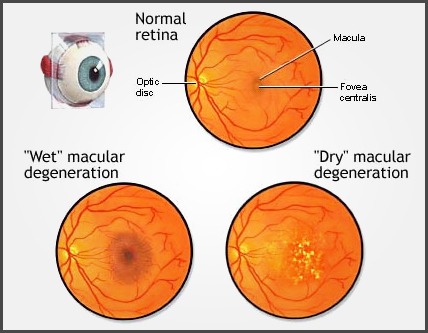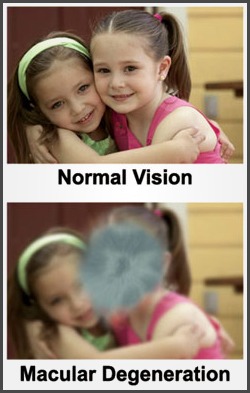Age-related macular degeneration (AMD) damages the part of the retina responsible for central vision and makes it difficult to see small details of objects. Side vision is not affected. If both eyes are affected, reading and other tasks requiring fine vision may become very difficult.

AMD is the result of ageing processes in the eye. Some of the layers of the retina thicken and waste material which is usually removed from the retina forms deposits, distorting the retina. This distortion can cause damage to the other layers of the retina. In about 10 per cent of cases, new blood vessels grow into the macula from beneath. These newly-formed (neovascular) vessels are fragile and often leak blood into the retina, where the blood causes scar tissue to form. The scarring severely blocks central vision. Other forms of macular degeneration are inherited and not associated with ageing.
Age-related macular degeneration is the major cause of vision impairment and blindness in Australia for people over the age of 50. Early AMD occurs in about 14 per cent of those aged 55 to 64 years, 18 per cent of those aged 65 to 74 years, and 30 per cent of those aged over 75 years. Men and women are equally affected. AMD accounts for almost 50 per cent of legal blindness and up to 70 per cent of seriously impaired vision in people over the age of 70 years.

At Beckenham Optometrist Rowena and Valerie use a range of specialised instruments including ophthalmoscopes, a digital retinal camera and slit-lamp microscope with high-powered lenses to examine the macula. Sometimes they may place a drop in the eye to dilate the pupil to get a better view of the internal structures. Another test that may be used is a grid pattern known as an Amsler chart. This is a regular grid that looks like a piece of graph paper. Patients with AMD often report that sections of the grid appear to be distorted or missing.
There is little that can be done to cure AMD, particularly in its more advanced stages. One study found that antioxidant vitamin and mineral supplementation assisted in halting the progression of AMD in a small percentage of patients. These supplements should be taken under the supervision of a health care professional as they may be associated with harmful effects.
People with AMD can be helped to continue functioning normally. Help in the form of low vision devices are available from Beckenham Optometrist and links to specialist low vision clinics including Vision Australia and Guide Dogs are established to enable patients to make the most of their vision.
For treatment of AMD to be effective, it must be diagnosed as early as possible. Regular eye examinations are the key to early detection of retinal changes and other signs of disease. Other important preventative measures include minimising exposure to UV light and cigarette smoke, both of which are associated with AMD. A low-fat diet rich in green leafy vegetables, nuts and fish may be beneficial in reducing the impact of AMD.
For more see: New Research into Macular Degeneration and The Latest in Eye Health Testing Technology




